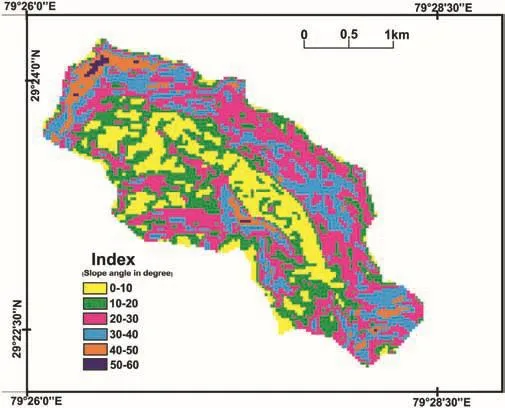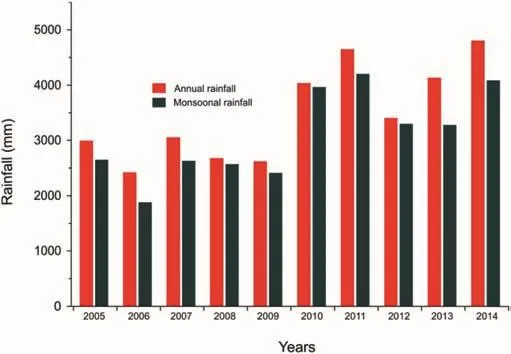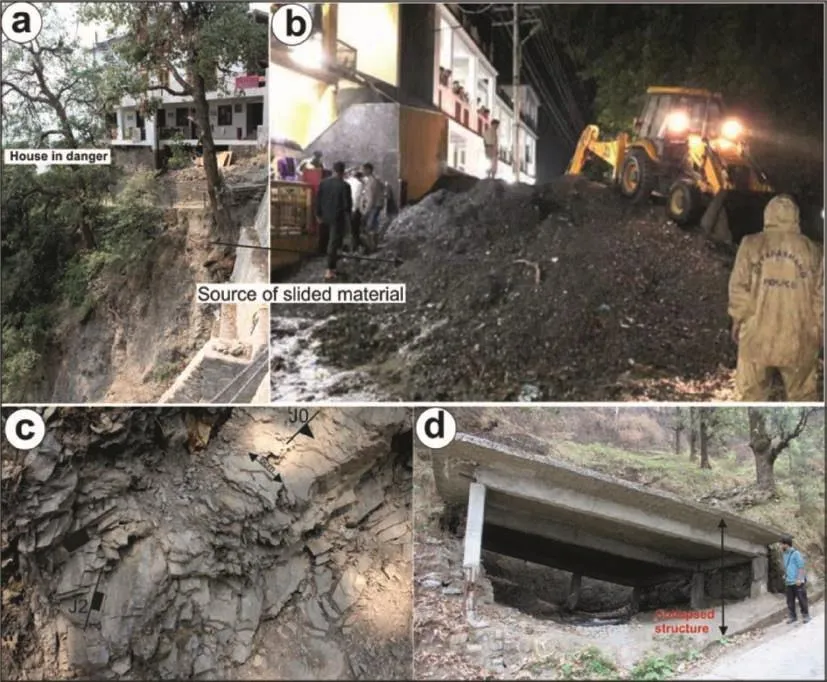Hill slope instability of Nainital City,Kumaun Lesser Himalaya,Uttarakhand,India
Nirvn Sh,Mohit Kumr,*,Rjeev Updhyy,Som Dutt
aDepartment of Geology(CAS),Kumaun University,Nainital,263001,India
bWadia Institute of Himalayan Geology,33 General Mahadeo Singh Road,Dehradun,248001,India
1.Introduction
As a major problem in the Himalayan region,landslide is responsible for loss of life and environment degradation(Panikkar and Subramanyan,1997).Tectonic activities coupled with slope failure give rise to the extensive mass movements in the region(Paul and Mahajan,1999).In Uttarakh and Himalayan region,several workers have been engaged in landslide investigations,landslide hazards zonation/marking and mitigation,and disaster management for decades.They have documented numerous landslides such as Malpa rock fall in 1998(Pant and Luirei,1999),Okhimath landslide in Mandakini valley(Sah and Bist,1998),Amiya landslide in Kumaun region(Pant and Luirei,2005),Varunawat landslide in 2003(Gupta and Bist,2004),Agastyamuni landslide in 2005(Rautela and Pande,2005),slope failure in Alaknanda valley(Joshi and Kumar,2006)and Asi Ganga landslide in 2012(Gupta et al.,2013;Martha and Kumar,2013),which affected the region and caused huge loss of life and property in Uttarakh and.
Nainital City in the Kumaun Himalaya region is very sensitive to slope failure and has suffered numerous slope failures and landslides.Due to the sensitivity to slope failure,many researchers have worked in this region.Pande(1974),Hukku et al.(1977),Anbalagan and Singh(1996)and Puniya et al.(2013)investigated the Rusi village bypass road,Gupta et al.(2016)identified the subsurface tension using the geophysical methodin the Rais Hotel.Kumaret al.(2017)carried out the slope stability analysis and geotechnical investigations of Balia-Nala landslide.The present study focuses on the engineering geological mapping,different rock mass classification methods and rock slope kinematics.Different rock mass classification methods and slope kinematics will help in the construction of new buildings in the city.
2.Study area
The investigated area of Nainital City lies between 29°22′15.79′′and 29°24′16.27′north latitude,79°26′6.05′and 79°28′24.82′east longitude.Geologically,this region is located in the Outer Lesser Himalaya,bounded by Sher-Ka-Danda ridge to the north-east,Ayarpatta ridge to the south-west and China peaks to the northwest.As shown in Fig. 1,the investigated area lies north to the main boundary thrust(MBT)(Valdiya,1988)and is dissected by Nainital lake fault(NLF)that passes through the center of Nainital lake(Middlemiss,1890).Besides aforementioned structures,some branches of NLF also exist in this area.Nainital lake was formed by the rotational movement along the NLF(Valdiya,1988)~40-50 thousand years ago(Singhvi et al.,1994).Lithology of the area consists of green and purple slates,dolomitic limestone,silty sandstone and rhythmite,collectively forming Krol Formation(Heim and Gansser,1939;Fuchs and Sinha,1974;Pal and Merh,1974;Valdiya,1980;Puniya et al.,2013;Kumar et al.,2017).Krol Formation can be further divided into two parts,namely Lower Krol(Korl-A or locally known as Manora slate composed of purple slate and Krol-B or locally known as Hanumangarhi slate composed of grayish to greenish slates)and Upper Krol(Krol-C composed of dolomitic limestone and silty sandstone,Krol-D composed of thickly bedded dolomitic limestone and Krol-E composed of rhythmite and dolomitic limestone).

Fig. 1.(a)Location of the study area,Nainital City(Google Earth Map)and(b)Geological and structural map of the study area(after Valdiya,1988).
The major geomorphic features of this region are characterized by mountain peaks,hill slopes,topographic depressions and debris cones.The slope mainly varies between 20°and 40°,occasionally over 50°at some places(see Fig. 2).Hill slopes are generally covered with slope of wash materials,and the topographic depressions are occupied by the lacustrine deposits.One large debris cone has a high population density,and has multiple infrastructures,including Head post office,Uttarakh and High Court and Nainital club.The drainage of the study area consists of several small rivulets in a dendritic,trellis,and parallel pattern(see Fig. 3).Some natural springs also exist due to occurrence of karst network,lithological contacts,and secondary discontinuities(faults and joints)observed in the area.

Fig. 2.Slope map of the study area(extracted from ASTER DEM 30 m using Arc GIS 10.0).
The study area has a tropical climate with a mean temperature of~25°C in summer and near to 0°in winter(Gupta et al.,2016).The regional climate is influenced by the two major atmospheric phenomena,namely the southwest Indian monsoon during summer and mid-latitude westerlies in winter.The average annual rainfall is~3500 mm,of which 85%is received during the southwest monsoon season between June and September(see Fig. 4).Local convection also causes some rainfall during pre-monsoon season.The heavy rainfall during the monsoon months triggers the debris f l ow and slope failure,endangering the lives of people and safety of infrastructures.Earlier researchers have documented increases in the number of landslides and debris flows during years suffering heavy rainfall(Gupta et al.,2016).
3.Methodology
To delineate the discontinuities,geological mapping has been carried out where outcrops are exposed.This study focuses on the different rock mass classification methods,i.e.rock mass rating(RMR),kinematics analysis of the slopes,slope mass rating(SMR)and factor of safety(FOS).RMR is widely applied to tunnels,slopes(for SMR calculation)and foundations(dam,bridges and other civil structures)(Bieniawski,1989).During field mapping,the orientations of different discontinuities and uniaxial compressive strength(UCS)were measured using Schmidt hammer method as per the International Society for Rock Mechanics(ISRM)suggested methods(ISRM,1978,1981,2007;Bieniawski,1989;Brencich et al.,2013).The data of spacing of discontinuities(joints),conditions of discontinuities(aperture,roughness,type of filling and weathering condition),rock quality designation(RQD),groundwater condition,and orientations of slopes with dip angles have been collected carefully.All these parameters were used to calculate the RMR in the study area.Kinematics analysis of the slope has been analyzed under stereographic projection with the help of Dips.5.0 software of Rock science.Kinematics can be defined as the motion of objects without reference to the forces that cause them to move(Goodman,1989).This is an excellent tool to investigate possible failure modes of rock masses(Hussain et al.,2015).

Fig. 3.Drainage map of the study area.

Fig. 4.Annual and monsoon rainfall data for the Nainital City.
SMR can be obtained from RMR by adding adjustment factors,i.e.SMR=RMR+F1F2F3+F4.For those parameters,we have:
(1)F1depends on the angle between the strikes of joints and slope face.Its range varies from 1 to 0.15(Romana,1985).It can be represented asF1=(1-sinA)2,whereAdenotes the angle between the strikes of slope face and joints(in the form of absolute value).
(2)F2refers to the joint dip angle in the planar mode of failure.Its value varies from 1 to 0.15.And it matches the relationship ofF2=tan2Bj,whereBjrepresents the joint dip angle.
(3)F3reflects the relationship between slope face and joint dip angles.
(4)F4refers to the adjustment factor for the method of excavation.
FOS is calculated based on Hoek and Bray(1981)for planar and wedge failure conditions.In this method,the friction angle is considered to be 25°for slate and 35°for dolomite,and cohesion is considered as 40 kPa(Waltham,2002).
4.Results and discussion
The main rock types in the area contain slate,sandstone,rhythmite,limestone and dolomitic limestone,belonging to Krol Formation(Krol-A,Krol-B,Krol-C,Krol-D,and Krol-E)(see Figs.1 and 5).Engineering geological map(see Fig. 5)shows that most of the area is covered by slope with wash materials,and at some locations,outcrops of slates,dolomitic limestone,sandstone and rhythmite are exposed on the surface.

Fig. 5.Engineering geological map of the study area showing outcrop locations and various discontinuities.
Nainital City is surrounded by the peaks from three orientations and the valley is open from SE-SW direction,i.e.the outlet of the lake.Many parts in this region have slopes of 40°-60°,for example Uttarakhand High Court,GB Pant zoo area and Pasan Devi temple area(see Fig. 2).Rock mass is moderately to highly deformed and dissected by 3-4 sets of joints(see Fig. 5).Ductile-brittle structures are identified which are associated with the NLF,and generate weak zones in the region.Field mapping reveals that Sher-Ka-Danda hill(or NE-SE portion of the area)is composed of slate that is weak,jointed and moderately weathered(see Appendix A).Argillaceous slate(Krol-A)is exposed along the slopes of Sher-Ka-Danda hill with lenses of dolomitic limestone.This slate is intersected with 3-4 sets of discontinuities(see Fig. 6c),which further reduces the strength of the rock.Based on the RMR classification method,rocks of this area fall into poor to fair classes(see Table 1).Stereographic projection analysis has been applied to understanding the kinematics of the slopes.This analysis is based on the Markland’s test.Kinematics analyses of slopes at locations L2,L3,L9,L12,L13,L16,L17,L20,L21,L23,L26,L27,L28,L31,L32,L34,L36,L38,L39,L40,L41,L45,L47 and L51 show that these locations are structurally controlled and not safe for any construction.As shown in Table 1 and Figs.7 and 8,52 locations have been analyzed for planar and wedge failures,among which 31 are unstable.Thus,40.38%area is stable and 59.62%is unstable.The internal friction angles of 25°and 35°,and cohesion of 40 kPa have been taken for slate,dolomitic limestone and sandstone,respectively,according to Hoek and Bray(1981).Both the dry and wet conditions have been considered during the FOS calculation.It shows that the FOS values are smaller than 1 for the landslide-prone sites(see Table 1).
Rainfall is a dominant factor which influences the chemical weathering,and controls the supply of moisture for chemical reactions and the removal of exposed soluble constituents.In the study area,the average overburden thickness is basically 10-15 m,with some places exceeding 15 m(see Figs.9-11).The rainwater percolates into the surface and increases the pore water pressure,promoting the failure along the discontinuity planes(Hoek and Bray,1981).The rain acts as lubricant along discontinuity surfaces,and facilitates the sliding process of rock.The same process has taken place at Location L42,triggering the Mall road slide in front of Alka hotel(see Fig. 6).

Table 1Data of geotechnical investigation at different locations in the study area.

Fig. 6.Field photographs showing(a)active landslide and house at risk due to a heavy rainfall;(b)materials from the activated landslide in photograph(a)stacking on the Mall road,Nainital City;(c)foliated and jointed slate with 3 sets of discontinuities;and(d)collapsed concrete structure at Location L42.

Fig. 7.Kinematic analyses of different locations showing planar failure and respective discontinuities.FC represents the friction circle.

Fig. 8.Kinematic analyses of different locations showing wedge failure and respective discontinuities.
All the geological cross-sections(A-A1,B-B1,C-C1,D-D1,E-E1 andF-F1)in this area show the relationships between slopes and discontinuities(see Figs.9-11).Cross-sectionA-A1(see Fig. 9)shows that Darham house area has S1 discontinuity.In this cross section,S1 has a higher angle than the slope with an angle 52°towards SE(140°)direction;but at the right hill,S1(65°/290°)and S2(60°/210°)form wedge failure condition.The northern flank of the lake has the same discontinuities but rock type is changed as slate.Geological cross-section(B-B1 in Fig. 9)prepared on the basis of field data shows that the overburden(loose material or slope wash material)thickness is 10-15 m.As shown in Fig. 10,Ayarpatta side(CandD)has 3 sets of joints and the opposite side(C1 andD1)has 4 sets of joints.

Fig. 9.Geological cross-sections along section lines A-A1 and B-B1 showing different relationships between discontinuities and slopes.

Fig. 10.Geological cross-sections along section lines C-C1 and D-D1 showing different relationships between discontinuities and slopes.

Fig. 11.Geological cross-sections along section lines E-E1 and F-F1 showing different relationships between discontinuities and slopes.
The slope angle also varies in 50°-60°.F-F1 cross-section represents the highest slope in this region,i.e.China’s Peak or over Uttarakhand High Court(see Figs.2 and 11).Discontinuities,S1(75°/115°)and S0(11°/275°)form brick-sized blocks in this region and promote the stone falling activity.On the other side,G.B.Pant high altitude Zoo region(F1)has an overburden thickness of 8-12 m,with discontinuity S0(52°/334°)parallel to the slope and S2(74°/120°)giving the passage to the slow movement of rock and rock materials in this region.Kinematics analysis in this region shows that most of the area is prone to planar failure and wedge failure(see Figs.7 and 8).All the field data have been analyzed and RMR values have been calculated for all the locations.RMR values vary from34 to65 in slates at locations L45 and L9,respectively.But in dolomitic limestone,RMR values are between 60 and 75 at locations L13 and L17,respectively.SMR values are also calculated for disturbed zone and range from 9 to 52.8 at locations L51 and L45,with the rock class varying from III to IV.FOS values of 0.9 and 0.96 at locations L51 and L45,respectively,also confirm the SMR results(see Table 1).
5.Conclusions
Along the hill slopes of Nainital City,there are 3 or 4 joint sets.The RMR values obtained from the study area range from 34 to 75 and the SMR values vary between 9 and 45.5.RMR method shows that the rocks of the area lie in III-IV classes.The SMR values vary between 9 and 52.8 with rock classes varying between classes III and IV.Kinematics analyses also reveal that most joint planes intersect with each other and form different potential failures.Of the 52 locations,10 locations are susceptible to the wedge failure and 21 locations to planar failure.FOS values calculated for the failure-prone locations range from-0.518 to 0.96 for planar failure and-0.28 to 1.08 for wedge failure at various locations.In this study,it is also observed that kinematic analysis,SMR,and FOS support each other.Based on the present study,it is concluded that the discontinuity planes,neotectonic activity,overburden,and unplanned civil construction should be taken care in formulating future development plans and managing the landslide-prone areas for minimizing the loss of human lives and properties in Nainital City.
Conflict of interest
The authors wish to confirm that there are no known Conflicts of interest associated with this publication and there has been no significant financial support for this work that could have influenced its outcome.
Authors are thankful to Department of Geology,Kumaun University at Nainital for necessary laboratory facilities.
Appendix A.Supplementary data
Supplementary data related to this article can be found at https://doi.org/10.1016/j.jrmge.2017.09.011.
Anbalagan R,Singh B.Landslide hazard and risk assessment mapping of mountainous terrains-a case study from Kumaun Himalaya,India.Engineering Geology 1996;43(4):237-46.
Bieniawski ZT.Engineering rock mass classification.New York:John Wiley and Sons,Inc.;1989.
Brencich A,Cassini G,Pera D,Riotto G.Calibration and reliability of the rebound(Schmidt)hammer test.Civil Engineering and Architecture 2013;1(3):66-78.
Fuchs G,Sinha AK.On the geology of Nainital(Kumaun Himalaya).Himalayan Geology 1974;4:563-80.
Goodman RE.Introduction to rock mechanic.2nd ed.New York:Wiley;1989.
Gupta V,Bhasin RK,Kaynia AM,Tandon RS,Venkateshwarlu B.Landslide hazard in the Nainital city,Kumaun Himalaya,India:the case of September 2014 Balia Nala landslide.Natural Hazards 2016;80(2):863-77.
Gupta V,Bist KS.The 23 September 2003 Varunavat Parvat landslide in Uttarkashi city,Uttaranchal.Current Science 2004;87(11):1600-5.
Gupta V,Dobhal DP,Vaideswaran SC.August 2012 cloudburst and subsequent fl ash fl ood in the Asi Ganga,a tributary of the Bhagirathi River,Garhwal Himalaya,India.Current Science 2013;105(2):249-53.
Heim A,Gansser A.Central Himalaya:geological observations of the Swiss expedition in 1936.Zurich:Gebruder Fretz;1939.
Hoek E,Bray J.Rock slope engineering.London:The Institution of Mining and Metallurgy;1981.
Hukku BM,Srivastava AK,Jaitly GN.Measurement of slope movements in Nainital area.Engineering Geology 1977;4:457-67.
Hussain G,Singh Y,Bhat GM.Geotechnical investigation of slopes along the National Highway(NH-1D)from Kargil to Leh,Jammu and Kashmir(India).Geomaterials 2015;5:56-67.
International Society for Rock Mechanics(ISRM).International society for rock mechanics commission on standardization of laboratory and field tests:suggested methods for the quantitative description of discontinuities in rock masses.International Journal of Rock Mechanics and Mining Sciences&Geomechanics Abstracts 1978;15(6):319-68.
ISRM.Suggested methods for determining hardness and abrasiveness of rocks.In:Rock characterization,testing and monitoring:ISRM suggested methods.Ankara,Turkey:ISRM Turkish National Group;1981.p.95-6.
ISRM.The complete ISRM suggested methods for rock characterization,testing and monitoring.Ankara,Turkey:ISRM Turkish National Group;2007.p.628.
JoshiV,KumarK.Extreme rain fall events and associated natural hazards in Alaknanda valley,Indian Himalayan region.Journal of Mountain Science 2006;3:228-36.
Kumar M,Rana S,Pant PD,Patel RC.Slope stability analysis of Balia Nala landslide,Kumaun Lesser Himalaya,Nainital,Uttarakhand,India.Journal of Rock Mechanics and Geotechnical Engineering 2017;9(1):150-8.
Martha TR,Kumar KV.September,2012 landslide events in Okhimath,India-an assessment of landslide consequences using very high resolution satellite data.Landslides 2013;10(4):469-79.
Middlemiss CS.Geological sketch of Nainital with some remarks on the natural conditions governing the mountain slopes.Records of the Geological Survey of India 1890;21:213-34.
Pal D,Merh SS.Stratigraphy and structure of the Nainital area in Kumaun Himalaya.Himalayan Geology 1974;4:547-62.
Pande IC.Tectonic interpretation of the geology of the Nainital area.Himalayan Geology 1974;4:532-46.
Panikkar SV,Subramanyan V.Landslide hazard analysis of the area around Dehra Dun and Mussoorie,Uttar Pradesh.Current Science 1997;73(12):1117-23.
Pant PD,Luirei K.Malpa rockfalls of 18 August 1998 in the Northeastern Kumaun Himalaya.Journal of the Geological Society of India 1999;54(4):415-20.
Pant PD,Luirei K.Amiya land slide in the catchment of Gaula River,Southern Kumaun,Uttaranchal.Journal of the Geological Society of India 2005;65(3):291-5.
Paul SK,Mahajan AK.Malpa rockfall disaster,Kali valley,Kumaun Himalaya.Current Science 1999;76(4):485-7.
Puniya MK,Joshi P,Pant PD.Geological investigation of Nainital Bypass:a special emphasis on slope stability analysis,Kumaun Lesser Himalaya.In:Himalayan vulnerability,Uttarakhand,2013:learning for planning and action.Xpressions Print&Graphics Pvt.Ltd;2013.p.65-72.
RautelaP,PandeRK.Traditional input sin disaster management:the case of Amparav,North India.International Journal of Environmental Studies 2005;62(5):505-15.
Romana M.New adjustment ratings for application of Bieniawski classification to slopes.In:Proceedings of the international symposium on the role of rock mechanics in excavations for mining and civil works.Zacatecas:International Society of Rock Mechanics;1985.p.49-53.
Sah MP,Bist KS.Catastrophic mass movement of August 1998 in Okhimath area Garhwal Himalaya.In:Proceedings of international workshop cum Training programme on landslide hazard and risk assessment and damage control for sustainable development.New Delhi;1998.p.259-82.
Singhvi AK,Banerjee D,Pande K,Gogte V,Valdiya KS.Luminescence studies on neotectonic events in south-central Kumaun Himalaya-a feasibility study.Quaternary Science Reviews 1994;13(5-7):595-600.
Valdiya KS.Geology of Kumaun Lesser Himalaya.Dehradun:Wadia Institute of Himalayan Geology;1980.
Valdiya KS.Geology and natural environment of Nainital Hills,Kumaun Himalaya.Nainital:Gyanodaya Prakashan;1988.
WalthamT.Foundations of engineering geology.2nded.Tay lornd Francis Ltd.;2002.
 Journal of Rock Mechanics and Geotechnical Engineering2018年2期
Journal of Rock Mechanics and Geotechnical Engineering2018年2期
- Journal of Rock Mechanics and Geotechnical Engineering的其它文章
- Behavior of diatomaceous soil in lacustrine deposits of Bogotá,Colombia
- Assessment of natural frequency of installed offshore wind turbines using nonlinear finite element model considering soil-monopile interaction
- Behavior of ring footing resting on reinforced sand subjected to eccentric-inclined loading
- A new design equation for drained stability of conical slopes in cohesive-frictional soils
- Investigation of active vibration drilling using acoustic emission and cutting size analysis
- Numerical analysis of Shiobara hydro power cavern using practical equivalent approach
